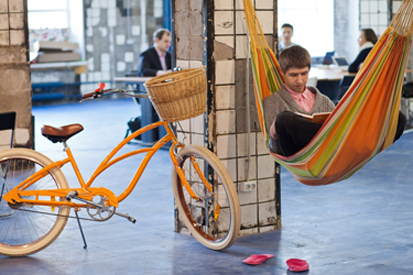Coworking:
Sharing a Workspace, Ideas, and Inspiration
by Wendy Priesnitz

One of the solutions being proposed for a variety of our society’s current problems is sharing. People are setting up networks – formal and informal, cooperative and for-profit – to share everything from cars, cottages, garden tools, bicycles, jobs, and workspaces. We’re finding that, in many cases, having access to things is more important than claiming ownership of them. Sharing saves money and storage space, lessens waste, and creates community.
Those principles all come into play in the growing popularity of coworking. Coworking is, at its basic level, about workspaces. They are shared working environments – often offices or studio spaces, although they can involve specialized shops or kitchens – where home- based workers, such as freelancers, independent contractors, computer programmers, consultants, those just starting up their businesses, and people whose work takes them on the road a lot can find a place to work. Typically, there are Wifi, free coffee, and other amenities; some have conference rooms, kitchens, and other common spaces. Coworking offers a solution to the problem of isolation that many freelancers experience while working at home, while allowing for an escape from the distractions of home.
But coworking is not just about sharing space, it’s about a community of people. Besides sharing a working environment, members share tips, advice, and ideas. Many coworking spaces function as business incubators or accelerators – helping new entrepreneurs learn the ropes of business while avoiding high rents. But more than that, coworking can actually be seen as a new business model – one based on openness, collaboration, accessibility, sustainability, and community. If you are an entrepreneur who believes that people can accomplish more working together than they can alone, then coworking is for you.
The phenomenon began about ten years ago. But the first use of the word “coworking” is credited to Bernie DeKoven to describe computer-supported collaborative work. DeKoven may be familiar to Natural Life Magazine readers as a fun theorist, author, game designer, and contributor to the New Games Foundation with Stewart Brand and co. of Whole Earth Catalog fame.
The movement is now growing quickly. Deskmag: the coworking magazine, which operates out of Berlin, Germany, reports that in 2013 more than 110,000 people work in one of the nearly 2,500 coworking spaces available worldwide. Compared to last year, there are now eighty-three percent more coworking spaces that serve a total of one hundred and seventeen percent more members. On average, according to the magazine, the number of coworkers is increasing by almost two hundred and fifty people each working day.
Their research found that most coworkers are in their late twenties to late thirties. Two-thirds are men, one third are women. The majority work in creative industries or new media. Slightly more than half are freelancers. However, the share of salaried employees is increasing as larger companies start to experiment with coworking, especially in the U.S.
The collaborative principle behind coworking has caused individual facilities to work together. In some cities – like Seattle, for instance, which was one of the early adopter of the ideas and is home to more than twenty coworking spaces – there are city-wide alliances. And, since coworking is a global phenomenon, there is collaboration at that level as well. Using a Coworking Visa, members of one space can use other coworking spaces around the world for free for a set number of days (three is the default). There are currently more than two hundred participating spaces, including more than one hundred in the U.S. and that many again in various other countries around the world.
Even Google is getting in on the trend, having opened a coworking space in East London, England, along with several local partners.
There are a number of conferences serving the movement, including Coworking Europe, in Barcelona, and the Global Coworking Unconference.
Coworking is redefining the way we work – improving our satisfaction and increasing our fun, improving the quality of our work, and enhancing our flexibility and creativity. Beyond that, the community building and support that comes with coworking spaces is something we all need if we’re to navigate the next few decades successfully.
As the number of coworking spaces grows and many of them become profitable businesses themselves, I hope those values of collaboration and sustainability don’t get lost. As guerilla gardener Ron Finley put it in his TED talk, “The thing about sustainability is you have to sustain it.”
Learn More
Working in the UnOffice: A Guide to Coworking for Indie Workers, Small Businesses, and Nonprofits by Genevieve V DeGuzman (Night Owls Press, 2011)
I’m Outta Here: how co-working is making the office obsolete by Drew Jones, Todd Sundsted, Tony Bacigalupo (NotanMBA Press, 2009)
The Style of Coworking: Contemporary Shared Workspaces by Alice Davies, Kathryn Tollervey (Prestel, 2013)
Wendy Priesnitz is Natural Life Magazine's editor. She is a journalist with over 40 years of experience and the author of 13 books, including Bringing It Home: A Home Business Handbook for Your and Your Family. The photo at the top of the article is courtesy zonaspace.
|

